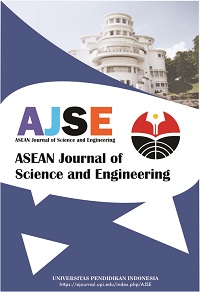Bed-Stretcher for Burial Process of COVID-19 Corpse: A Preliminary Design and Strength Analysis
Abstract
The number of COVID-19 corpses is highly increased since 2020. This situation tends to risk the health workers directly interacting with COVID-19 victims during the burial process. In Indonesia, the conventional method of burial process requires four to eight health workers. Thus, minimizing the number of involved health workers is needed. This paper aims to propose a bed-stretcher that assists the burial process of the COVID-19 corpses efficiently. Hence, the number of people involved can be minimized. The design considers a maximum weight of 2000 N of the coffin, which includes the corpse inside. The device is equipped with a shaft-pulley system, gear, and ratchet mechanism to lower the coffin inside the grave. The strength analysis of the shaft-pulley system by theoretical approach is conducted under static and fatigue loading conditions to estimate the service life. As a result, the calculated safety factor demonstrates a value of more than one, indicating the structure is safe under both static and fatigue loading conditions. Moreover, the device can be operated only by two health workers. In addition, this work is expected to contribute to the innovative idea of engineering products to overcome the Pandemic of COVID-19.
Keywords
Full Text:
PDFReferences
Al Farizi, S., and Harmawan, B. N. (2020). Data transparency and information sharing: Coronavirus prevention problems in Indonesia. Jurnal Administrasi Kesehatan Indonesia, 8, 35-50.
Arunkumar, K. N., Charan, Kashyap, K., Chirag, B. C., Kausthubh, R., and Keerthan, J. (2019). Design, Experiment and Fabrication of Multipurpose Stretcher for Patients. International Journal of Innovative Technology and Exploring Engineering, 8(6S4), 66–70.
Asriyanti, A., Septiani, T. D., Siagian, M. S. P., and Triawan, F. (2021). Portable Coffin Lowering Device for COVID-19 Corpse Handling: Education, Design Process, and Strength Analysis. Indonesian Journal of Multidiciplinary Research, 1(1), 41-54.
Bronzino, J. D., and Peterson, D. R. (2006). Wheeled Mobility: Wheelchairs and Personal Transportation. In Biomedical Engineering Fundamentals (pp. 1227-1242). CRC Press..
Budynas, R. G., and Nisbett, J. K. (2015). Shigley’s Mechanical Engineering Design, Tenth Edition. McGraw-Hill, New York.
Do, DucTrung., Nhu-Tung, Nguyen., and Hoang, Tien, Dung. (2020). Calculation of Residual Stress on the Surface Layer of Workpiece When Surface Grinding the AISI 1018 Steel. Journal of Engineering and Applied Sciences, 15, 2229-2233
Elyazar, I. R. F., Surendra, H., Ekawati, L. L., Djaafara, B. A., Nurhasim, A., Arif, A., Hidayana, I., Widyastuti, Oktavia, D., Adrian, V., Salama, V., Hamdi, I., Andrianto, A., Lina, R. N., Lestari, K. D., Shankar, A. H., Hamers, R. L., Thwaites, G., and Baird, J. K. (2020). Excess mortality during the first ten months of COVID-19 epidemic at Jakarta, Indonesia. MedRxiv, 165(2020), 1–22.
Finegan, O., Fonseca, S., Guyomarc’h, P., Morcillo Mendez, M. D., Rodriguez Gonzalez, J., Tidball-Binz, M., and Winter, K. A. (2020). International committee of the red cross (ICRC): General guidance for the management of the dead related to COVID-19. Forensic Science International: Synergy, 2, 129–137.
Jimenez‐Sotomayor, M. R., Gomez‐Moreno, C., and Soto‐Perez‐de‐Celis, E. (2020). Coronavirus, ageism, and Twitter: An evaluation of tweets about older adults and COVID‐19. Journal of the American Geriatrics Society, 68(8), 1661-1665.
Khoiriyah, N., Alfatih, S. A., Munir, M., and Triawan, F. (2021). Component Design and Strength Analysis of Coffin Lowering Machine for COVID-19 Corpse: A Problem-Based Learning. Indonesian Journal of Multidiciplinary Research, 1(1), 137-150.
Kirana, A. P., and Bhawiyuga, A. (2021). Coronavirus (COVID-19) Pandemic in Indonesia: Cases Overview and Daily Data Time Series using Naïve Forecast Method. Indonesian Journal of electronics, electromedical engineering, and medical informatics, 3(1), 1-8.
Kumar, S., Kathiresh, P. V. M., Nagaraj, S., Sahabudeen, H., and Karthik, K. (2018). Design and Optimization of Helical Gear Box. International Research Journal of Automotive Technology, 1(4), 51-55.
McMulkin, M. L., and Woldstad, J. C. (1995). Effects of Wheel Design on the Torques Applied to Large Hand Wheels. International Journal of Industrial Ergonomics, 15(3), 205–213.
Nurprasetio, I. P., Budiman, B. A., and Triawan, F. (2017). Failure investigation of plastic shredding machine’s flange coupling based on mechanical analysis. Indonesian Journal of Science and Technology, 2(2), 124-133.
Saptaji, K., Afiqah, S. N., and Ramdan, R. D. (2019). A review on measurement methods for machining induced residual stress. Indonesian Journal of Computing, Engineering and Design (IJoCED), 1(2), 106-120.
Wardani, L. K. (2003). Evaluasi ergonomi dalam perancangan desain. Dimensi Interior, 1(1), 61-73.
Zulaikah, S., Rahmanda, W. H., and Triawan, F. (2020). Foldable front child-seat design for scooter motorcycle: Strength analysis under static and dynamic loading. International Journal of Sustainable Transportation Technology, 3(2), 37-44.
DOI: https://doi.org/10.17509/ajse.v2i1.37785
Refbacks
- There are currently no refbacks.
Copyright (c) 1970 Universitas Pendidikan Indonesia

This work is licensed under a Creative Commons Attribution-ShareAlike 4.0 International License.












